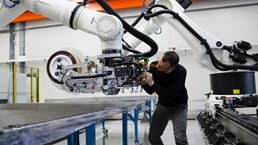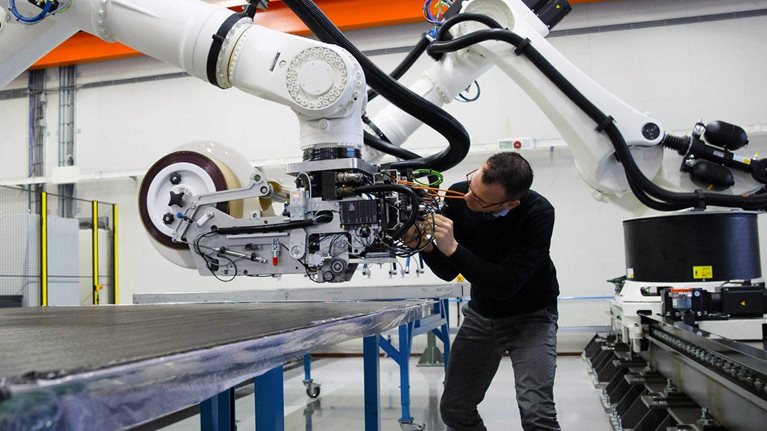Digitization is everywhere, but adoption is uneven across companies, sectors, and economies, and the leaders are capturing most of the benefits. Accelerating progress in AI and automation now bring further opportunities for users, businesses, and the economy. Europe, while making progress, is behind the United States and China. This briefing note was prepared for the European Union Heads of State Tallinn Digital Summit, which brought together heads of state and CEOs to discuss the steps needed to enable people, enterprises, and governments to fully tap into the potential of innovative technologies and digitization.
Table of contents
- The opportunity today
- The new wave of automation and AI technologies
- The impact on work
- 10 imperatives for Europe

The opportunity digitization presents today
Digital technologies have been evolving and disrupting the way we live, work, and organize for years. Yet they represent massive unrealized potential because of their ongoing advancement and evolution, along with their uneven adoption across companies, sectors and economies. Europe has a significant underexploited digitization opportunity.

Read our latest thinking on AI in Europe
Digitization of everything beyond big data and the Internet of Things
Stay current on your favorite topics
The signs of digitization are everywhere, from smart phones, the mobile internet, ecommerce, to cloud-based services that are used by individuals on the go, at home and at work, on the way to work—and as a way to get to work. Big data, advanced analytics, and the Internet of Things are transforming businesses as well as business and industrial processes.
The ability to capture and analyze enormous troves of data and establish machine-to-machine connectivity has significant potential to improve the efficiency of fixed assets such as machinery, oil fields, and buildings; it can also help companies streamline their operations in ways that were not possible before. Digitally enabled business models and capabilities are reshaping industries such as retail, transportation, finance, and manufacturing, and could transform many more.
Digitization is also transforming globalization. The amount of cross-border data flows has grown 45 times larger since just 2005 and is projected to increase by an additional nine times over the next five years as flows of information, searches, communication, video, transactions, and intracompany traffic continue to surge.
In addition to transmitting valuable streams of information and ideas in their own right, data flows enable the movement and reach of goods, services, finance, and people. Virtually every type of cross-border transaction now has a digital component. Currently about 15 percent of the global goods trade is conducted via international e-commerce, with much of it driven by platforms such as Alibaba, Amazon, eBay, Flipkart, and Rakuten. Beyond e-commerce, digital platforms for both traditional employment and freelance assignments are beginning to create a more global labor market.
Some 50 percent of the world’s traded services are already digitized. These transformations enable small and medium-sized enterprises around the world to export at far higher rates and reach customers and suppliers in ways only large companies were able to do before.
Digitization is progressing unevenly
Our use of the term digitization encompasses three aspects and their relative measures: digitization of assets; digitization of operations; and digitization of the workforce. The three aspects belong together; without usage and workforce changes, digital investments on their own are unlikely to yield results. In measuring each of these aspects, we find relatively large disparities across companies, sectors, and countries.
In Europe, as in the United States, the depth of usage of digital technologies diverges across companies, including those within the same sector (Exhibit 1). In most countries, a few sectors are relatively more highly digitized, for example financial services, media, and the tech sector itself. Many others are much less digitized, including asset-heavy sectors such as manufacturing and mining, quasi-public sectors such as health care and education, and fragmented industries such as hospitality and construction.

These differences matter: companies that are digital leaders in their sectors have faster revenue growth and higher productivity than their less-digitized peers. They improve profit margins three times more rapidly than average and, more often than not, have been the fastest innovators and the disruptors and transformers of their sectors—and in some cases beyond them. While the most digitized sectors tend to have higher productivity growth and wage growth, these are not the largest sectors in the economy today in terms of share of GDP or employment. By comparison, sectors lagging in digitization tend to be the largest by output and employment—and often those with relatively low productivity growth.
Spending on health care, for example, is 10 percent of GDP or more in European countries including France, Germany, and the United Kingdom, yet the sector is one of the least digitized. Likewise, construction makes up close to 7 percent of employment in Western Europe, yet is behind in digitization, which we estimate could help raise the sector’s productivity by 40 percent.
Most countries have barely reached their potential. We estimate that Europe has captured only 12 percent of its potential from digital technologies, ranging from 10 percent in Germany to 17 percent in the United Kingdom. That puts Europe behind the United States, which itself has captured only 18 percent of its potential (Exhibit 2).

Europe has digital startups and considerable innovation, but, unlike the United States and China, has been largely unable to translate that consistently into global digital platforms. There are some exceptions, including Spotify in music, but other platforms including Skype and PriceMinister have been acquired by non-European companies. As a consequence, Europe is a net importer of digital services, running a digital trade deficit with the United States amounting to nearly 5.6 percent of total EU-US services trade.
Digitization is a significant opportunity for Europe
The European market has the potential to be the largest digital market in size and value. Cross-border digital flows are of particular relevance to Europe, which, together with the United States, is at the center of the world’s digital networks. Europe has the largest share of intraregional data flows among all regions. But many barriers still impede the free flow of cross-border data within the European economy; only 15 percent of EU consumers buy online from another EU country, whereas nearly 50 percent do so domestically, according to the EU Commission.
We find that a completed Digital Single Market could double the ratio of cross-border to national digital trade of goods and services. Digital cross-border flows beyond e-commerce, including web and video applications that have the potential to be produced domestically, could also increase as companies take advantage of the single market’s scale.
Through further digitization, Europe could gain an additional €2.5 trillion of GDP in 2025, according to our estimates, lifting GDP 10 percent above baseline projections for that year. This estimate is based on innovations that are already spreading through European economies and have the potential to offer substantial economic benefits in the near future. In reality the boost to GDP could be greater as the digital frontier continues to move forward. The consumer benefit may also be much bigger, but cannot yet be quantified.
European businesses on the whole are optimistic about the digital age. A recent McKinsey Global Institute survey found that 55 percent of German executives expect increased digitization and automation to have a positive impact on their businesses in the coming years, and just 12 percent expect a negative impact. Companies are similarly optimistic about the data-driven technological advances characterized as Industry 4.0. This is partly based on experience with earlier automation: Germany’s productivity and employment sustainability rose in the 1990s after it invested significantly in manufacturing automation and built up a strong electronics sector.
Back to top
The new wave of automation and AI technologies
Recent advances in robotics, machine learning or AI are pushing the frontier of what machines are capable of doing in all facets of business and the economy. These advances will provide national economies with a much-needed boost to productivity and enable companies to realize substantial performance gains. Three factors are driving the acceleration of automation technologies:
- Progress with machine-learning algorithms, especially through the development of deep learning and reinforcement-learning techniques based on neural networks.
- Exponentially increases in computing capacity, been aggregated in hyper-scalable data centers and accessible to users through the cloud.
- Generation of massive amounts of data that can be used to train machine learning models, for example through daily creation of billions of images, online click streams, voice and video, mobile locations, and sensors embedded in the Internet of Things.
The combination of these breakthroughs has led to spectacular demonstrations like DeepMind’s AlphaGo. Formidable multi-decade long technological challenges must still be overcome, however, before machines can match human performance across the range of cognitive activities and approach “Artificial General Intelligence.” However, significant progress has been made in specific “narrow’ AI applications.
Would you like to learn more about the McKinsey Global Institute?
Benefits to business go beyond labor substitution
For companies, successful adoption of these evolving technologies will significantly enhance performance and can be a competitive advantage and differentiator. Some of the gains will come from labor substitution, but automation also has the potential to enhance productivity, raise throughput, improve predictions, outcomes, accuracy, optimization, and enable discovery of novel solutions and possibilities.
Already today, a range of automation technologies is generating real value, in Europe and elsewhere. Companies across sectors from agriculture and health care to media and pharmaceuticals use them to identify fraudulent transactions, personalize financial products, diagnose diseases, optimize pricing and scheduling in real time, and carry out predictive maintenance in manufacturing, among other uses.
For example, Luxottica creates personalized marketing campaigns based on real-time analytics of geospatial and behavioral customer data. Google has applied artificial intelligence from its DeepMind machine learning to its own data centers, cutting the amount of energy they use by 40 percent.
Investment in automation technologies including AI is growing rapidly, dominated by digital companies such as Amazon, Baidu, and Google. European companies including ABB, Bosch, BMW, and Siemens are investing in AI, but overall Europe is behind in external AI investment, which totaled $3 to $4 billion in 2016, compared with $8 to $12 billion in Asia and $15 to $23 billion in North America, according to our global review. The United States and China both have AI “ecosystems”—clusters of AI entrepreneurs, financiers, and AI users—and have issued national strategic plans in the past 18 months with significant AI dimensions, in some cases backed up by funding initiatives (Exhibit 3).

AI and automation will boost productivity
The application of AI and the automation of activities can enable productivity growth for entire economies. Demographic effects such as aging and falling birth rates are set to dramatically slow the growth in labor supply in Europe, and elsewhere. Productivity growth will need to increase sharply to sustain economic growth—this at a time when productivity growth has been less than stellar in most economies. At a macroeconomic level, based on our scenario modeling, we estimate automation alone could raise productivity growth on a global basis by up to 1.4 percent annually.
Back to top
The impact on work
Even as automation technologies boost productivity and growth, they will bring with them large-scale transitions for workers, affecting multiple sectors, the mix of occupations, the skills required, and the wages earned.
Half the current activities carried out by workers in Europe could be automated
For Europe’s five largest economies—France, Germany, Italy, Spain, and the United Kingdom—we estimate that about $1.9 trillion in wages and 62 million workers are associated with technically automatable activities (Exhibit 4).

While nearly all occupations will be affected by automation, only about 5 percent consist of activities that are fully automatable using currently demonstrated technologies. However, we find that about 30 percent of the activities in 60 percent of all occupations could be automated. This means that many workers will work alongside rapidly evolving machines. Worker skills will evolve for everyone, from welders to landscape gardeners, mortgage brokers—and CEOs; we estimate about 25 percent of CEOs’ time is currently spent on activities that machines could do, such as analyzing reports and data to inform decisions.
The rate and extent of automation will depend on several key factors: technical feasibility, the cost of deploying the technologies (also taking into account the cost and time to replace existing technologies), the labor-market dynamics (including labor supply quantity, quality, and associated wages), benefits beyond labor substitution, as well as social factors (for example social acceptance).
Much discussion today focuses on the first factor—technical feasibility—and suggests very high rates of job automation. However, consideration of the other factors suggest that actual adoption will be much slower than technical feasibility alone would suggest.

Brief lessons from history
We have seen steep employment declines in sectors in various sectors and countries in the past, first out of agriculture and more recently manufacturing, even as overall employment has grown. In the United States, manufacturing fell from 26 percent of total employment in 1960 to below 10 percent today, while in Germany, manufacturing jobs halved from almost 40 percent in 1970 to below 20 percent today.
Although technology raises labor productivity growth and may displace workers within a sector, history shows that overall employment also grows, particularly when looking over longer periods of time and across the whole economy. Productivity growth and job growth go together over the mid and long term because output growth speeds up. Prices fall, new goods and services are introduced, and markets expand. When there has been a tradeoff between aggregate employment and productivity levels, it has been short-lived. In Germany, for example, employment and productivity both increased in more than 80 percent of the 10-year periods between 1960 and 2016, while in the United States, employment and productivity both have increased in 99 percent of the 10-year periods since 1929.
Worker transitions will be significant challenges
The impact on work will largely depend on the rate of adoption of automation technologies and the rate at which economies grow and create demand for new work. Assuming robust demand and economic growth (partly fueled by productivity growth which in turn benefits from automation), most scenarios suggest there should be about enough jobs for everyone.
However, complex transitions will be unavoidable. The places (and sectors) where new jobs are created may not be the same as where the old ones are lost. Certain occupations will decline while others grow. Different skills and capabilities will be required to thrive in this shifting environment of new and evolving occupations and work alongside machines. Wages will be under pressure for some categories of workers, especially those with less than a college education, according to our research, depending on sector and country. Given the scale of these shifts, the transition challenges for workers at all skill levels are likely to be significant and felt especially across the advanced economies.
In Europe, the challenge will be to generate enough incremental labor demand to offset the displacement caused by automation. European economies, particularly ones with low economic growth, will need to grow and innovate in order to create new work activities for existing and new occupations. In terms of skills and wages, the risk is that automation will exacerbate income inequality and the lack of income advancement that has characterized the past decade across much of the advanced economies, stoking economic, social, and political tensions.
Technology offers some solutions to the future of work
Against this challenging background, technology can help create new jobs and new opportunities to earn income, including outside of the technology sector itself. Just as computers created jobs within and beyond the computer industry, the current wave of technologies has begun to do the same. For example, ecommerce has given rise to growth in related activities such as package delivery.
Digital talent platforms such as LinkedIn have begun to improve matching of workers with jobs, creating transparency and efficiency in labor markets, and thereby raising GDP. While it is early days, there is already evidence that such platforms can raise labor participation and working hours. At the same time, new forms of technology-enabled work are adding variety to the traditional 9-5 job. Our research finds that 20 to 30 percent of the working-age population in the European Union is engaged in independent work, and just over half of these workers supplement their income and have traditional jobs, or are students, retirees, or caregivers. Many who are not working full time would like to work more.
Back to top
Imperatives for Europe
Europe has aspirations to become a leading digital society, but still needs to achieve the full scalability to realize that goal. Capitalizing on the opportunities from digital will require decisive choices around a set of imperatives:
1. Lead by example: European governments could set ambitious digitization targets for their own public sectors, leading by example while raising efficiency and improving citizen interaction and delivery of citizen services, as Estonia has done. They could also spur digital catch-up in lagging sectors like construction via public procurement rules or regulation, as well partnerships to achieve common economic growth and productivity goals. SMEs can benefit from good practice exchange and interaction with large digital platforms as well as access to enabling capabilities and supports.
2. Accelerate efforts to complete a Digital Single Market: Common legal and regulatory frameworks can enable digital companies to scale within and beyond individual countries and realize the potential of the single market. Enabling the free movement of data could be enshrined as a new European freedom. Recent efforts to frame a model of talent mobility and data flows is a good example of supporting the goal of a digital single market. Policy makers will need to make the case more clearly that digital technologies will be a force for greater prosperity, even as they maintain a high level of data protection and digital rights.
3. Embrace and enable the creation and growth of large-scale digital platforms and digital innovators: Digital platforms are powerful tools to boost cross-border commerce and give small and mid-sized companies global reach, but also to facilitate job matching. In many ways, they are the real engines in the digital age. At the same time, their winner-takes-all dynamics also require careful monitoring and, possibly, regulatory frameworks evolved for the digital age, to sustain competition and data access.
4. Invest to become a leading digital ecosystem and digital destination: Europe’s future as a thriving economy will depend on its ability to step up investments in digital infrastructure and digital skills and to deepen and expand its digital ecosystem. Further it will be important to continue attracting digital foreign direct investment that complements and enables homegrown digital innovation and talent.
5. Invest more and experiment more with AI and other new technologies: While the continent has many AI and next gen startups, with vibrant ecosystems in the making in cities including Amsterdam, Barcelona, and Stockholm, there is still considerable scope to support the development of these companies in terms of incentives and access to capital. Governments can act as a platform facilitator for many AI innovation and scaling experiments, as the United Kingdom has been doing in health care.

Harnessing automation for a future that works
Prepare for the future of work
6. Strengthen demand, unlock investment, and revive economic and productivity growth: Sustaining aggregate demand and restoring investment in Europe will be critical to ensure sufficient incremental labor demand at a time when automation will displace many jobs and many parts of Europe still feel the aftermath of the crisis. Our research shows that European companies are holding back on investment because of uncertainties about the future of the Single Market, but most are eager to digitize and want greater European economic integration.
7. Spur entrepreneurship, business dynamism, and job creation: New products, new activities, and new business models will be especially important in Europe, as the continent’s relatively high wage levels will likely speed up automation adoption. We estimate that the digital portion of economies will double in the next 10 years in Europe if companies are sufficiently innovative.
8. Improve human capital development, especially education and skills: Education will allow both faster digitization and preparation of workers for the transition. Policy makers and business leaders working with education providers could improve science, technology, engineering, and math (STEM) skills through school systems, and put a new emphasis on creativity as well as critical and systems thinking. Effective retraining will be critical for mid-career workers who will need to transition to new occupations and to different types of work alongside machines.
9. Improve labor market dynamics and enable more diverse forms of work: Greater mobility and better matching of talent with opportunity is needed across Europe to increase fluidity; digital platforms can support that, and open up myriad opportunities for individuals to earn income outside of traditional employment contracts. Labor institutions could ensure portable benefits for workers and provide greater support to independent workers and others already navigating the future of work.
10. Rethink worker supports: The European welfare state dating back to the days of Bismarck will need to adapt to become more resilient. If automation (full or partial) does result in a significant reduction in employment and/or greater pressure on wages in some strata of the population, some ideas such as conditional transfers, adapted social safety nets, different forms of taxation, or even universal basic income may need to be considered and tested, as Finland and the Netherlands are currently doing.
Back to topAuthor James Manyika gave the keynote speech at the summit and held a fireside chat at the event to discuss these ideas and more.


